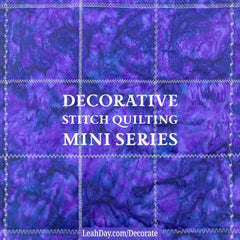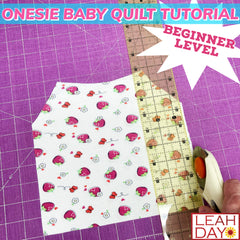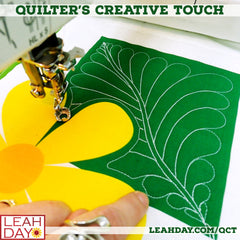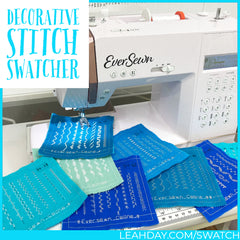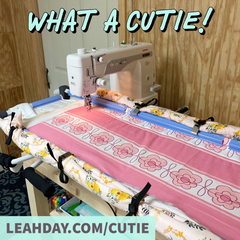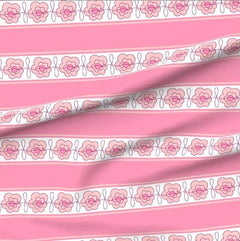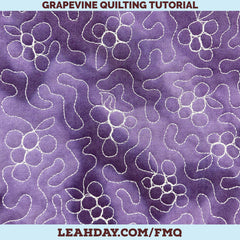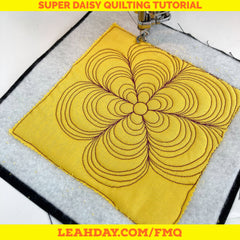Are you in the market to buy a new sewing machine? In this video and article I'd like to share my top 10 tips for purchasing your first sewing machine and making sure you're completely satisfied with the purchase.
Tip #1 - What do you want from your new machine?
No matter what you're planning to use your machine for, whether it's sewing, patchwork, quilting, upholstery, or home decor, it's really important to understand the features you are looking for. Do you need a knee lifter? Would brighter lights be a necessary feature? What sewing machine feet do you need to make your next project?
Make a list of everything you want, and if you don't know what you want at all, take a trip to a local sewing machine store and spend a day familiarizing yourself with the different options and features machines are built with today.
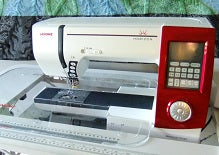
Tip #2 - What is your trade-in value?
If you have a machine on hand that you plan to trade it, call around to the local dealers in your area to learn the trade-in value of your machine. Sometimes dealers won't be able to tell you this amount over the phone, so you may need to make a special trip out to the stores to see how much value your current machine has.
Sometimes trade-in value is helpful and will bring down the cost of your new sewing machine to a more affordable level. Sometimes it's a total rip off and you can sell the machine for far more on Ebay instead!
If this is your first machine purchase, you obviously won't have another machine to trade in, but it's still good practice to do your research and understand the value of sewing machines in general. The typical price for a low to mid range sewing machine with knee lifter, thread cutter, and decorative stitches is around $800 - $1000.
Tip #3 - What dealers are nearby?
If you're totally new to sewing or quilting you may not even know what dealers are in your area! As you can see from the above three tips, it's important to know what's available nearby and how the staff at those shops treat you.
I live close to a shop that carries several great machine brands, but I would never be comfortable purchasing from them. Instead I've driven 30 minutes to 3 hours away to shop at dealers that are patient, friendly, and I trust to give me a great price.
Tip #4 - What feet come with the machine?
Yes, I have a foot fetish - for sewing machine feet at least! Many techniques like inserting an invisible zipper and stitching a blind hem can be made much, much easier when you use a special foot for that task.
Purchasing extra feet for your machine is a great way to increase it's capability and value. Many times I've sold machines on Ebay for $500 - $1000 more than what I paid because I added several feet to the machine.
Make sure to ask about the feet compatible with your machine to see what is currently available and how easily you can order extra feet. Does the dealer stock a huge selection of feet compatible with your machine or do you have to special order them?
Does your manufacturer change the style and compatibility of feet often or rarely? This is a bit of a weird question to ask, but it's important. I can easily find feet for my Bernina 1230 which was built in 1984 because Bernina only changed their foot compatibility one time and dealers can usually carry both sets of feet.
Contrast this with my Viking Ruby 6570 which was built in 1979. I've struggled to find compatible feet for this machine. When I ran a search for Viking feet, I found a complicated lettering and numbering system that looks like at least 12 different types of feet! If you own a machine compatible with Group G feet, those feet will not work with the newer Group 7 machines. It's frustrating and complicated and I've accidentally purchased incompatible feet several times.
#5 - How can your new sewing machine be upgraded?
This might also be something that you haven't considered - what other gear or equipment can you purchase for your machine either now or later?
Some machines have embroidery units that you can purchase separately. Machines with larger harp space (the distance between the needle and motor of the machine) can sometimes be set up on a rail system like a longarm machine.
This may be getting into an arena that is way beyond what you want to consider right now, but it's good to keep in mind. If you plan to sell your machine having additional features and tools is never a bad thing and can increase the perceived value of the machine.
#6 - How easily can you find feet and gear for your machine?
While your sewing machine may have the ability to be super charged and fire powered, finding this extra gear can be challenging. How easily can you find the extra gear, feet, and tools you want to use? Do you need to buy it all now, or will this machine be supported by the brand for a few years to come?
Again, this may not be a concern for you right at the moment, but it's a good thing to keep in mind. You definitely don't want to get caught wanting a super sized hoop or special foot and suddenly find your dealer isn't carrying gear for that machine model anymore.
#7 - How secure is the foot connection?
When you first set down to test drive your machine one of the most important things to check is the foot connection. How does the foot attach to the machine? Is it screwed on the side, latched on the top, or is it a quick change foot that pops on and off from the bottom?
This is important because an insecure connection can really wreck havoc with your ability to sew accurate seams. Basically - if the foot is moving, so is your seam allowance!
Look for a very strong connection between the foot and machine and minimal wobble and movement of the foot. The less it moves, the better your machine should stitch.
#8 - Take your time buying your new machine!
Never, ever, under any circumstances purchase a machine on a whim or as an impulse buy. Just like buying a car, refrigerator, or any other piece of equipment, buying a sewing machine should always involve research and careful consideration.
I've bought two machines on impulse and absolutely regretted both purchases. If I'd spent more time testing the machine I would have easily seen that it wasn't a good buy for me.
#9 - Plan a day to play with the sewing machine
The best way to buy a sewing machine is to plan an entire day around the purchase. Arrive at the dealership with a project in hand and make it clear that you want to test drive the machine by working on this real project.
The dealer will need to teach you how to wind a bobbin and thread the machine. They will also need to run through the basic commands and stitch settings of the machine. If your dealer isn't willing to do these things for you, walk away and shop somewhere else!
As you work on the machine, pay attention to how it stitches and how easy it is to work with. Are there clunky features or annoy beeps and buzzes? Do you have enough light to see what you are stitching?
After working for awhile, take a break and go eat lunch and consider your options. Make sure to get the price for the machine before you leave and have the dealer add taxes and any other fees so you know exactly how much the bill will be so you don't have any surprises.
If you're satisfied with the test you've stitched, return to the store and buy the machine. If not, test drive a different machine. Really take your time with this process so you'll be 100% satisfied with your new sewing machine.
#10 - Understand your financing options
As I mentioned in the video, I've financed two machines in the past because I couldn't afford to purchase the machine outright. The store ran a credit check, I filled out the loan agreement, and then received monthly bills for the machine.
Make sure to ask about the interest rate of the loan and if there are any deals for 0% interest for a certain number of months. Many times dealers will over 0% for 12 or 24 months, which means as long as you pay the bill off within that amount of time, you will not be charged interest on the purchase.
Getting a loan for a sewing machine might seem crazy, but it is an option that's available if you need it.
So now that you know how to buy a sewing machine, you might want to check out some sewing machine reviews!

